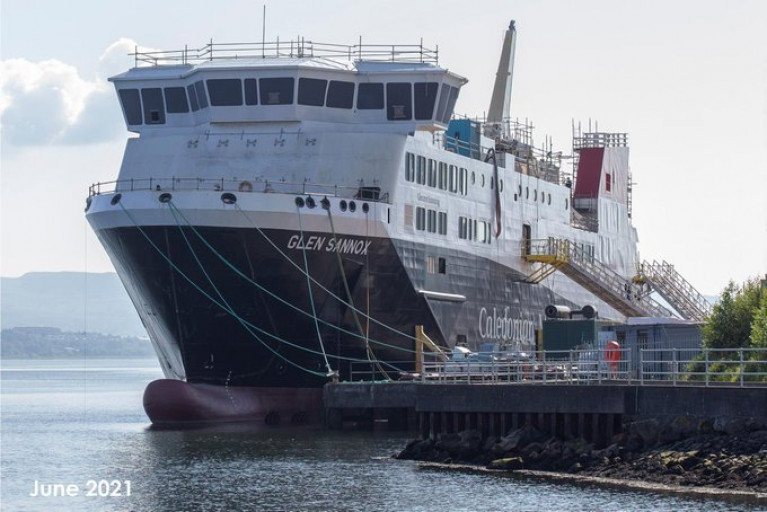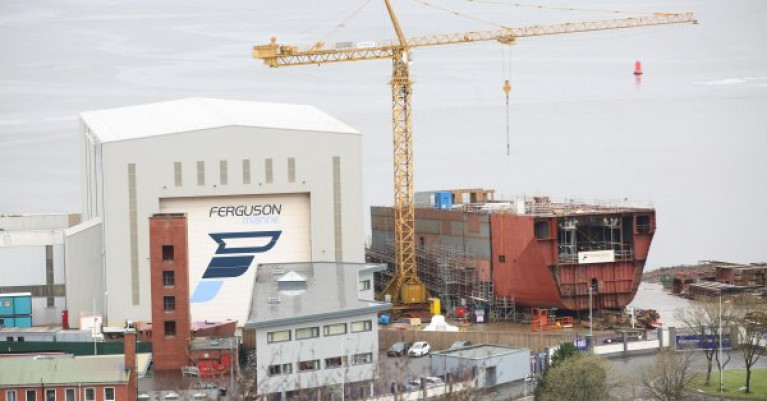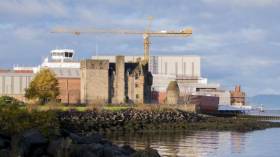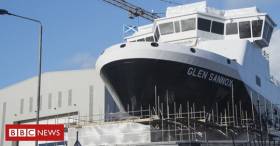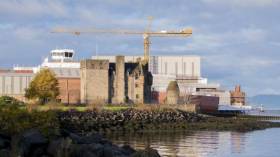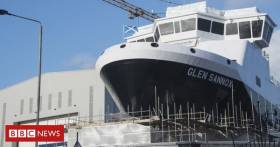Displaying items by tag: Ferguson Marine
Delays of up to a further five months to the completion of two long-awaited CalMac ferries were announced yesterday by shipyard Ferguson Marine, writes The Scotsman.
The latest setback was blamed on a shortage of skilled workers and Covid restrictions at the Scottish Government-owned shipyard in Port Glasgow.
MV Glen Sannox, being built for the main Isle of Arran route between Ardrossan and Brodick, is now due to be finished between July and September next year, compared to the previous estimate provided to MSPs last August of between April and June next year – three months behind.
Its unnamed sister ferry, codenamed hull 802, earmarked for the Skye-Harris-North Uist route, is now scheduled for completion between April and July 2023, compared to between December 2022 and February 2023 – up to five months behind.
A spokesperson for Ferguson Marine (Port Glasgow) said: “The Covid-19 pandemic caused six months of disruption in 2020 and productivity has continued to be impacted due to a further shutdown in January 2021 and the introduction of additional safety measures.
Much more to read here from the Clydeside yard.
Boss in Scotland Says Ferry Operators Will Be ‘Nervous’ About Ordering from Shipyard
In Scotland, a western based ferry boss has warned commercial operators will now be “nervous” of ordering new vessels from the Ferguson shipyard on the Clyde, amid the ongoing fallout from a contract to build two dual-fuel (ferries) to operate on the west coast.
A report by MSPs into the procurement and delivery of the two vessels for the CalMac network slammed the process as a “catastrophic failure” earlier this month. Caledonian Maritime Assets Limited (CMAL) awarded Ferguson, then owned by Jim McColl’s Clyde Blowers Capital.
The £97 million contract to build the ferries in 2015. But the process was blighted by delays, spiralling costs and a breakdown in relations between CMAL, which owns the ferries run by CalMac, and shipyard bosses.
The vessels have still to be completed and are expected to cost at least double the original contract value, with Ferguson having been nationalised last year after falling into administration.
More here reports the HeraldScotland on the ongoing shipyard saga and for a related story of recent months.
Scottish Shipyard Signs £15m Contracts with Firms for Ferry Support
Scottish shipbuilder Ferguson Marine (Port Glasgow) has placed three contracts, worth more than £15 million, with companies to continue work on two CalMac ferries
It’s hoped that the move, The National reports, is in order to further progress the completion of MV Glen Sannox and the as-yet unnamed Hull 802, will create and secure more than 200 jobs in the supply chain.
The contracts include the supply of electrical and control equipment by Wartsila’s Scottish subsidiary, Wartsila Ships Electronics Services.
The Port Glasgow company’s Inverclyde-based firm Blu Marine is to provide support for the dual fuel vessels’ passenger areas, while Babcock, Dales Marine and McEvoy Engineering will manufacture pipework.
Ferguson says it has spent the last six months managing the contracts, allowing them to bring in some supply contracts from the previous shipyard owner.
For more on the shipyard which went into administration in 2019 click here.
Shipyard in Scotland: Offshore Firm Benefits As Taxpayer Millions Spent On Fixing Damage Already Done
Shipyard Ferguson Marine which is owned by the Scottish Government, has ploughed nearly £3m into two companies without going to competitive tender to help resolve the fiasco over the delivery of two new (island) lifeline ferries, the Herald on Sunday can reveal.
A £2.12m contract has been given to an offshore company to complete even more design changes for one long delayed vessel due to service Scotland's busiest ferry crossing which Afloat.ie adds is to the Isle of Arran, where the 'year-round' operated Ardrossan-Brodick route is the nearest CalMac crossing to N.Ireland.
The taxpayer-funded award has been made to Isle of Man-based International Contract Engineering Ltd to supply engineering servies for the stalled construction of MV Glenn Sannox to "correct and complete" the design.
The Isle of Man, a self-governing territory that is part of the British Crown but enjoys separate autonomy, since its days as an Edwardian seaside resort has more recently has been accused of selling companies' escape from taxes and transparency.
Details of the taxpayer spend comes after it emerged £777,500 was given to Kirkintilloch-based Alliance Project Controls Ltd to supervise the construction work. That contract also did not go out to competitive tender.
For further reading on this ongoing shipyard saga story click here.
The busiest ferry crossing in Scotland, reports The Herald, has ground to a halt for safety reasons in a move that could lead to six weeks of disruption over a busy school holiday period.
Fifteen sailings between Brodick on the Isle of Arran and Ardrossan have been cancelled since Sunday and the first sailings of tomorrow have already been dropped because of a fault with the aging ferry's mooring equipment.
On Tuesday there were no sailings at all during the day, with the first seven journeys cancelled. Only the 4.40pm from Brodick and another to return to the island were able to operate as CalMac said it needed to berth on the island overnight.
The first sailings of tomorrow (Thursday, 12 March) have already been dropped with no news of any further crossings expected till after a 10am review. Travellers are being warned all services are liable to disruption or cancellation at short notice.
On top of that, a fault with both mezzanine decks, means the 1000 passenger and 110 car capacity of the vessel will be cut until repairs can be carried out.
The latest calamity to hit CalMac's MV Caledonian Isles has angered islanders who have demanded a long overdue temporary replacement to allow vital supplies and drugs to reach the largest island in the Firth of Clyde (Arran: dubbed Scotland in miniature).
It comes as CalMac bosses have said the £300m ferries "shambles" at Ferguson Marine's shipyard (see related last story) in Port Glasgow is causing knock-on 'major disruption' for island communities up and down the west coast of Scotland.
Dual fuel replacement Arran ferry Glen Sannox and her as yet unnamed sister were due to enter service in mid-2018 but the calamitous contract has doubled in price and work on the vessels won't be finished until at least 2022.
Ferguson Marine in Port Glasgow was handed a £97 million contract to build two the ferries in 2015.
For more about the beleagured newbuild pair and performance of CalMac sailings in 2019, click here.
Scottish Shipyard on the Clyde Has Deadline for Nationalising Postponed
Scottish National Party ministers, The Herald writes, have extended the deadline for finding a buyer for the last civilian shipyard on the Clyde.
Finance Secretary Derek Mackay told MSPs the marketing of Ferguson Marine in Port Glasgow could take 50 per cent longer than anticipated.
The business, which employs 300 workers, went into administration last month after a £97m contract for two CalMac ferries ran two years late schedule and £100m over budget.
When Mr Mackay took the yard under public control on August 16, he said ministers would nationalise it unless there was a viable commercial offer within four weeks.
However in an update at Holyrood, he marketing it would now last another two to four weeks. He said the priority for ministers was safeguarding jobs and finishing the boats.
He said: “The Scottish Government will at all times remain open to discussions with any parties interested in securing a viable commercial future for the yard. But we will also explore the option of keeping the yard in public ownership, and how this might protect sustainable shipbuilding on the lower Clyde.”
For further reading click this link
Shipyard in Scotland Rescued Could Create More Jobs to Complete Controversial Ferry Project
Additional jobs,The Scotsman writes, could be created at newly nationalised Ferguson Marine in order to complete the two vessels which nearly sank the shipyard, Scotland's economy secretary Derek Mackay has announced.
Speaking after the first meeting of the Programme Review Board, set up by the Scottish Government to run the yard, Mr Mackay suggested that workers who had been made redundant as Ferguson Marine faced administration, may be rehired.
However, he admitted that the Board had not yet looked at the firm's books, but said the aim was to ensure the ferries were completed at the "lowest possible cost to the taxpayer".
The Board was established last week to rescue the Port Glasgow shipyard as it faced administration after a huge over-run on a contract to complete two Caledonian Maritime Assets Ltd (CMAL) ferries. Ministers effectively nationalised the shipyard under an agreement with the administrators which will see them buy the facility if no private bid emerges within the next month.
The yard, which employs 300 staff, had faced closure five years ago, but was saved by SNP economic adviser and billionaire businessman Jim McColl, and then won the £97m public contract to build the two ferries for Caledonian MacBrayne. However as costs mounted, the Scottish Government loaned £45m to Ferguson Marine in an attempt to get the ferries completed - money it may now have to write off.
For further reading click here on the much delayed duel-fuel ferries destined to serve the Isle of Arran and on the Uig Triangle services.
Clydeside: Ferguson Shipyard Nationalised by Scottish Government
On the Clyde the Ferguson shipyard in Port Glasgow has been nationalised by the Scottish government.
Ministers reports BBC News, will now operate the yard under a management agreement with administrators, which will see the Scottish government buy the facility if no private buyer is found within four weeks.
Ferguson has been involved in a dispute with the Scottish government over the construction of two ferries for CalMac.
About 300 people work at the yard.
The deal means the yard will no longer be owned by industrialist Jim McColl, who could not persuade ministers to pay more than the £97m contract price for the disputed ferries.
The agreement also means work on the CalMac ferries, and other contracts, can continue while efforts to find a commercial buyer get under way.
Administrator Deloitte described the ferry contract as being "materially behind schedule and over budget".
More on this latest development can be read here
In a decision by the Scottish government it is "ready and willing" to take Ferguson shipyard into public ownership, Economy Secretary Derek Mackay has announced.
As BBC News reports, the minister said this was to avert the yard's closure with the loss of 350 jobs, and to complete two ferries being built there for Cal Mac west coast services.
The move follows legal notice being served that the business faces administration by the end of this week.
Mr Mackay said the government remained open to other investors.
But in a statement, he added that it was essential to act without delay, to secure the yard, its workforce and the unfinished ships.
A letter has been sent to Ferguson Marine, and its sole shareholder, industrialist Jim McColl, saying the Scottish government is hopeful that directors and creditors "recognise the importance of completing that transfer as quickly and smoothly as possible".
More here on the shipyard story.
Scottish Shipyard: 350 Jobs at Risk as Ferguson Directors Serve Notice of Administration
The Independent reports, around 350 jobs are at risk after the directors of a shipyard on the River Clyde in Port Glasgow served notice of their intent to go into administration, five years after it staved off closure.
The decision was taken ”with great regret and disappointment”, said Gerry Marshall, the chief executive of Ferguson Marine Engineering Limited.
He added: “This decision has not been taken lightly, but the directors do not consider there to be any other options in the current circumstances. However, the directors will continue to support the shareholder and the Scottish Government to realise a positive outcome for the business and its employees.”
The shipyard was previously in administration five years ago until it was bought by Clyde Blowers Capital (CBC).
Ferguson Marine won the £97m fixed price contract to build the MV Glenn Sannox and a second Hull 802 for CalMac, which is due to be deployed in the Outer Hebrides.
The shipyard’s parent company, owned by Jim McColl, also criticised Caledonian Maritime Assets Ltd (CMAL) and the Scottish Government in the wake of the move.
To read further click here on this development.


























